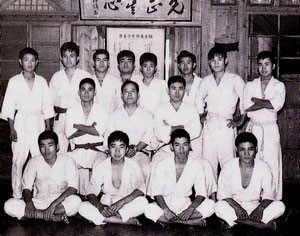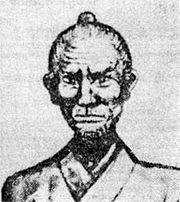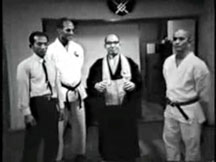The history of Matsubayashi-ryu begins after World War II when Grand Master Shoshin Nagamine officially founded the style in 1947.
Nagamine Sensei opened his first dojo in 1942 and —according to Charles C. Goodin— named it the Tomari Ken Yu Kai. It was destroyed during the war. He named the style Matsubayashi-ryu in 1947 and opened a temporary dojo in Makishi in 1948. In 1953 he finally opened his permanent dojo and named it the Matsubayashi-Ryu Kododan Karate and Ancient Martial Arts Studies. The term Matsubayashi comes from the Okinawan pronunciation of the characters for Pine Forest. Matsu means pine and the word forest translates to Hayashi. When the two are placed together, Hayashi is pronounced as Bayashi, making it Matsubayashi. The term Shorin-Ryu comes from the Shaolin Buddhist Temple in China. Shorin means Shaolin and Ryu roughly translates to style or system. More literally, Ryu can mean river, which Nagamine Sensei felt reflected his view that the art of karate, and specifically Matsubayashi-Ryu, is a living, flowing thing.
Nagamine Sensei also created the name “Matsubayashi” out of respect for two great Karatemen, Sokon “Bushi” Matsumura and Kosaku Matsumora, who, in turn, taught two of his most influential teachers, Chotoku Kyan and Choki Motobu. Also, Nagamine Sensei’s nickname growing up was “Gaajuu Maachuu” sometimes pronounced “Chippai Matsu”, which means “tenacious pine tree.”
In 1960 James Wax, an ex-American serviceman and the first American Black Belt in Matsubayashi-Ryu, opened a Matsubayashi-Ryu dojo in Dayton, Ohio. Two years later, Nagamine Sensei sent a senior student, Ansei Ueshiro, to the United States to firmly establish Matsubayashi-ryu in North America.
It was at Sensei Ueshiro’s dojo in New York City that Zenko Heshiki (see Zenko Heshiki sensei videos here) trained before opening a dojo on West 72nd Street in Manhattan with Sensei Arthur Drago. Sensei Heshiki was born in Okinawa in 1938. His grandfather, Zensei, was a Karate sensei and student of Chomo Hanashiro, himself a student of Sokon Matsumura and Ankoh Itosu. Sensei Heshiki’s dojo prospered, and at one time he had over 40 active black belts and over 200 students.
It was there that Sensei Owen Masters began training in 1967. He went on to open his own dojo on West 86th Street in Manhattan at the Gelabert Art Gallery where David Troup began his training in 1987. During the late 1990s, Sensei Owen Masters merged his dojo with Sensei Max Crevani’s Shorin-ji Bushido on West 72nd Street.


